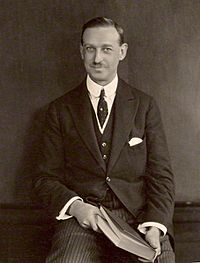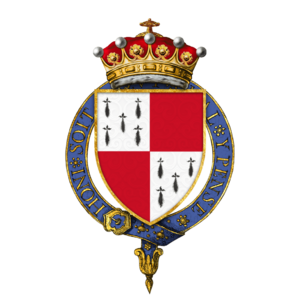James Stanhope, 7th Earl Stanhope facts for kids
Quick facts for kids
The Earl Stanhope
|
|
|---|---|
 |
|
| Leader of the House of Lords | |
| In office 21 February 1938 – 14 May 1940 |
|
| Prime Minister | Neville Chamberlain |
| Preceded by | The Viscount Halifax |
| Succeeded by | The Viscount Caldecote |
| Lord President of the Council | |
| In office 3 September 1939 – 10 May 1940 |
|
| Prime Minister | Neville Chamberlain |
| Preceded by | The Viscount Runciman of Doxford |
| Succeeded by | Neville Chamberlain |
| First Lord of the Admiralty | |
| In office 27 October 1938 – 3 September 1939 |
|
| Prime Minister | Neville Chamberlain |
| Preceded by | Duff Cooper |
| Succeeded by | Winston Churchill |
| President of the Board of Education | |
| In office 28 May 1937 – 27 October 1938 |
|
| Prime Minister | Neville Chamberlain |
| Preceded by | Hon. Oliver Stanley |
| Succeeded by | The Earl De La Warr |
| First Commissioner of Works | |
| In office 16 June 1936 – 27 May 1937 |
|
| Prime Minister | Stanley Baldwin |
| Preceded by | Hon. William Ormsby-Gore |
| Succeeded by | Sir Philip Sassoon, Bt |
| Parliamentary Under-Secretary of State for Foreign Affairs | |
| In office 18 January 1934 – 16 June 1936 |
|
| Prime Minister | Ramsay MacDonald Stanley Baldwin |
| Preceded by | Anthony Eden |
| Succeeded by | Viscount Cranborne |
| Parliamentary Under-Secretary of State for War | |
| In office 10 November 1931 – 18 January 1934 |
|
| Prime Minister | Ramsay MacDonald |
| Preceded by | The Lord Marley |
| Succeeded by | The Lord Strathcona and Mount Royal |
| Parliamentary and Financial Secretary to the Admiralty | |
| In office 24 August 1931 – 10 November 1931 |
|
| Prime Minister | Ramsay MacDonald |
| Preceded by | Charles Ammon |
| Succeeded by | Lord Stanley |
| Civil Lord of the Admiralty | |
| In office 11 November 1924 – 7 June 1929 |
|
| Prime Minister | Stanley Baldwin |
| Preceded by | Frank Hodges |
| Succeeded by | George Hall |
| Parliamentary Secretary to the War Office | |
| In office 14 December 1916 – 10 January 1919 |
|
| Prime Minister | David Lloyd George |
| Preceded by | Position established |
| Succeeded by | Position abolished |
| Member of the House of Lords Lord Temporal |
|
| In office 20 April 1905 – 15 August 1967 Hereditary Peerage |
|
| Preceded by | The 6th Earl Stanhope |
| Succeeded by | The 11th Earl of Harrington (as viscount Stanhope of Mahon) |
| Personal details | |
| Born |
James Richard Stanhope
11 November 1880 |
| Died | 15 August 1967 (aged 86) |
| Nationality | British |
| Political party | Conservative |
| Spouses | Lady Eileen Browne (1889–1940) |
| Parents | Arthur Stanhope, 6th Earl Stanhope Evelyn Pennefather |
James Richard Stanhope, 7th Earl Stanhope (born November 11, 1880 – died August 15, 1967) was an important British politician. He was a member of the Conservative Party. Before 1905, people knew him as Viscount Mahon.
Contents
Early Life and Family
James Richard Stanhope was the oldest son of Arthur Stanhope, 6th Earl Stanhope. His mother was Evelyn Henrietta Pennefather. His uncles were Edward Stanhope and Philip Stanhope, 1st Baron Weardale.
Military Service
In 1901, James Stanhope became a second lieutenant in the Grenadier Guards. This is a junior officer rank in the army. He served in South Africa during the Second Boer War. After the war ended in 1902, he returned home.
Political Journey
In 1905, James Stanhope became the Earl Stanhope after his father passed away. This meant he joined the House of Lords. The House of Lords is part of the UK Parliament. He gave his first speech there in 1909.
First Government Roles
His first government job was in 1918. He worked for the War Office, which manages the army. He held this role until 1919 under Prime Minister David Lloyd George.
In 1924, he became the Civil Lord of the Admiralty. This role helped manage the Royal Navy. He served under Prime Minister Stanley Baldwin until 1929. In the same year, he joined the Privy Council. This is a group of advisors to the King or Queen.
Roles in the National Government
When the National Government was formed in 1931, he continued to serve. He worked for the Admiralty again in 1931. Then, he became the Under-Secretary of State for War from 1931 to 1934. After that, he was the Parliamentary Under-Secretary of State for Foreign Affairs. This meant he helped with international relations. In 1934, he received a special honor. He became a Knight of the Garter. This is a very old and important award.
Cabinet Positions
In June 1936, he joined the Cabinet. The Cabinet is a group of top government ministers. Prime Minister Baldwin made him First Commissioner of Works. This role was in charge of government buildings.
When Neville Chamberlain became Prime Minister in 1937, Stanhope got a new job. He became the President of the Board of Education. This meant he was in charge of schools and education. In 1938, he also became the Leader of the House of Lords. This made him the main government spokesperson in the House of Lords.
Later in 1938, he became the First Lord of the Admiralty. This was the head of the Royal Navy. He continued to lead the House of Lords at the same time.
World War II and Beyond
When Second World War started in 1939, big changes happened. Winston Churchill took over as First Lord of the Admiralty. Stanhope then became the Lord President of the Council. He kept his role as Leader of the House of Lords. He held these jobs until Churchill became Prime Minister in 1940. After that, he did not hold any more government jobs. He gave his last speech in the House of Lords in 1960.
In 1940, a book called Guilty Men was published. It said that Stanhope and other politicians had not prepared Britain well for the war. It also said they tried to avoid conflict with Nazi Germany. Some people later disagreed with these ideas.
Personal Life
Lord Stanhope married Lady Eileen Browne. She was the oldest daughter of George Browne, 6th Marquess of Sligo. They did not have any children. Lady Eileen passed away in 1940 at age 51.
In 1952, he inherited more noble titles. These included the titles of Earl of Chesterfield and Baron Stanhope. However, he continued to be known as The Earl Stanhope. He passed away in August 1967 when he was 86 years old.
When he died, his titles of Earl Stanhope and Earl of Chesterfield ended. Other titles, like Viscount Stanhope of Mahon, went to his relative, William Stanhope, 11th Earl of Harrington. Lord Stanhope left his family home, Chevening, to the nation.
Arms
 |
|

